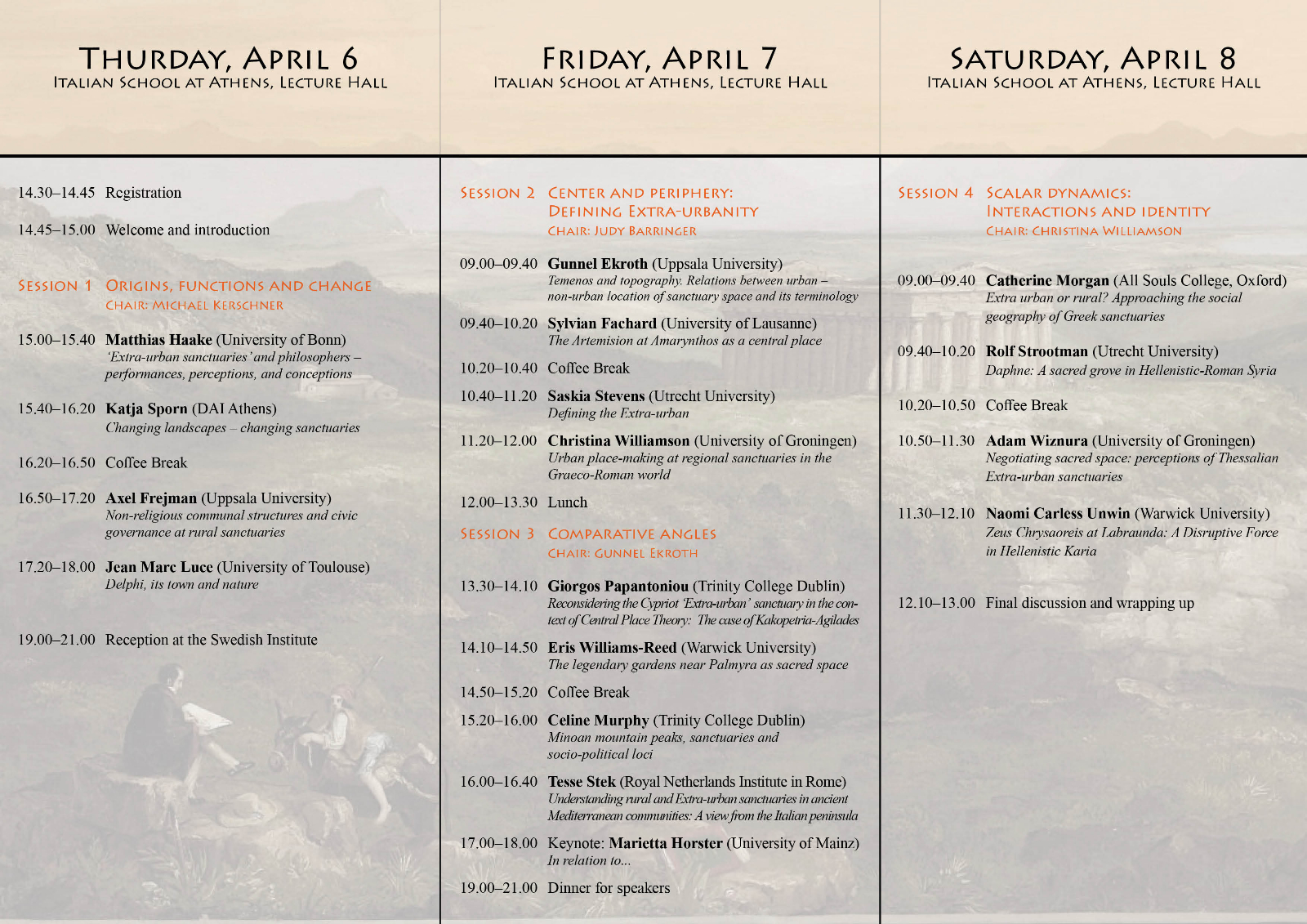Session 1: Origins, Functions and Change

Abstracts of Session Papers
Thursday 2023-04-06 | 15:00 | 15:40
‘Extra-urban sanctuaries’ and philosophers – performances, perceptions, and conceptions
Matthias Haake (University of Bonn)
Abstract
Greek sanctuaries were places that attracted the attention of philosophers in antiquity from the Archaic period until late Antiquity. This also applies to those sanctuaries that are referred to as extra-urban in scholarship. In my paper I will focus on three aspects: first, I will consider the evidence for the presence of philosophers in extra-urban sanctuaries; second, I will analyse whether this presence allows any conclusions regarding the perception of extra-urban sanctuaries among philosophers; third, in a final step, I will discuss whether conceptions of extra-urban sanctuaries can be found in philosophical texts.
Thursday 2023-04-06 | 15:40 | 16:20
Changing landscapes – changing sanctuaries
Katja Sporn (DAI Athens)
Abstract
Nothing in the world is stable, not even as regards to sanctuaries which do not change their place themselves. Nevertheless, both the organizational and the political situation around them and their function might change. So sanctuaries can be situated away from any settlements or cities, but eventually be integrated into a housing or even a fortification context. On the other site, sanctuaries in settlements might well continue to live and even evolve after the abandonment of settlements. The paper will address modes of change and will ask for the reasons behind them.
Thursday 2023-04-06 | 16:20 | 16:50
Thursday 2023-04-06 | 16:50 | 17:20
Non-religious communal structures and civic governance at rural sanctuaries
Axel Frejman (Uppsala University)
Abstract
Rural sanctuaries are as a rule considered in terms of religious functions. However, public buildings not primarily of religious character have been noted archeologically at numerous rural sanctuaries, as well as in the literature and epigraphic record, for example prytaneia and bouleuteria, but also stoai, theaters and stadia. Some of these structures have even been suggested to have originated at sanctuaries, and Olympia has been highlighted as the only site in Archaic and Classical Greece to exhibit both a Prytaneion and a Bouleuterion, features considered characteristic of the polis. These structures could be situated both inside and outside of the temenos. This paper investigates the spatial distribution of and form of structures connected to civic administration at rural sanctuaries, comparing both the situation between sanctuaries, and between cities and sanctuaries. Where are administrative structures located and what can the form and location tell us about the importance and use of these structures? In a second step, the paper considers the implications of administrative structures in the governance of the individual sanctuary. Both supra state collective governance and autonomy can be suggested in certain cases, in addition to the normal polis governed sanctuary. Such types of governance do not easily fit in to the common understanding of rural sanctuaries as controlled by a near-by urban centre.
Thursday 2023-04-06 | 17:20 | 18:00
Delphi, its town and nature
Jean Marc Luce (University of Toulouse)
Abstract
Delphi’s relationship to Nature is paradoxical. On one hand, the sanctuary of Apollo, where the Pythia was sitting, laid inside a town. Not a small village, rather a middle size town of at least 5000 people, probably even more in some periods. The sanctuary did not sit on the border, but was enveloped by houses on the Eastern, Western and Southern side, not so much on the Northern. On the other hand, poetry, when referring to Delphi, is almost silent about the town, but emphasizes on the natural landscape: mostly surrounding mountains, natural sources, vegetation. The purpose of this paper is to analyse this strange paradox, in the light of the French School’s new program on the town of Delphi, and, based on a comparison with Olympia, to question the panhellenic nature of the site.
